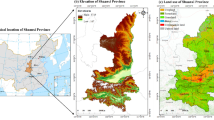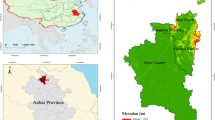Abstract
Road construction will have a large impact on the ecosystem in the road area, and carbon stock, as an important indicator to measure the scale and quantity of primary productivity of the ecosystem, will also change, but the specific pattern is not clear. It is important to study the impact of road construction on carbon stock for regional ecosystem protection and sustainable economic and social development. Based on the InVEST model, this paper quantifies the spatial and temporal changes of carbon stocks in Jinhua, Zhejiang Province, from 2002 to 2017, using remote sensing image classification data land cover types as model driving data, geodetector, trend analysis, and buffer zone analysis methods, explores the driving effect of road construction on carbon stocks, and analyzes the spatial and temporal impacts of road construction on carbon stocks within the buffer zone. Results indicate that the total carbon stock in the Jinhua area showed a decreasing trend during the 16 years, decreasing by about 8.58 × 106 t. The spatial changes in the areas with higher carbon stocks were not significant. The explanatory power of road network density on carbon stock reaches 37%, and the anisotropic effect of road construction on carbon stock is strong and had a significant driving effect on carbon storage reduction. The new highway construction will accelerate the rate of carbon stock decline in the buffer zone, and the spatial situation is generally “the farther away from the highway, the higher the carbon stock.”





















Similar content being viewed by others
Data availability
Some or all data, models, or code that support the findings of this study are available from the corresponding author upon reasonable request.
References
Alam SA, Starr M (2013) Tree biomass and soil organic carbon densities across the Sudanese woodland savannah: a regional carbon sequestration study. J Arid Environ 89:67–76
Bai L (2019) Quantifying the spatial heterogeneity influences of natural and socioeconomic factors and their interactions on air pollution using the geographical detector method: a case study of the Yangtze River Economic Belt China. J Clean Prod 232:692–704
Baral H, Keenan RJ (2014) Spatial assessment and mapping of biodiversity and conservation priorities in a heavily modified and fragmented production landscape in Northcentral Victoria Australia. Ecol Indic 36:552–562
Bo L, Luo YB (2020) Spatio-temporal characteristics and influencing factors of China’s urban NOx emissions: a spatial stratified heterogeneity perspective. Acta Scientiae Circumstantiae 40(02):687–696
Caro C (2020) Ecosystem services as a resilience descriptor in habitat risk assessment using the InVEST model. Ecol Indic 115:106426
Chen SG, Yang YS (2007) Research review on total belowground carbon allocation in forest ecosystems. J Subtropical Resources and Environ 01:34–42
Fan SD, Liu ZH (2022) Research on time series change and influencing factors of land use in Guangzhou city based on geodetector. Southwest China J Agricul Sci:1–21
Giardina CP, Ryan MG (2000) Evidence that decomposition rates of organic carbon in mineral soil do not vary with temperature. Nature 404(6780):858–861
Goldstein JH (2012) Integrating ecosystem-service tradeoffs into land-use decisions. Proc Natl Acad Sci U S A 109(19):7565–7570
González-García A (2020) Quantifying spatial supply-demand mismatches in ecosystem services provides insights for land-use planning. Land Use Policy 94:104493–104493
Han Y, Ding ST (2022) Spatial and temporal distribution and driving factors of carbon storage in Zhongtiao Mountain ecosystem in southern Shanxi Province. China Environ Sci:1–9
He XH, Xu YT (2022) Temporal and spatial variation and prediction of regional carbon storage in Zhongyuan urban agglomeration. China Environ Sci 42(06):2965–2976
Jia XL, Zhou WX (2020) Impact analysis of expressway construction on ecological carrying capacity in the Three-River Headwater Region. J Traffic Transp Eng:7(5)
Kong JQ, Du ZY (2019) Prediction of land use change and its influence on carbon stocks in the middle reaches of Heihe River. J Desert Res 39(03):87–97
Li HQ, Li YN (2014) Carbon budget of alpine Potentilla fruticosa shrubland based on comprehensive techniques of static chamber and biomass harvesting. Acta Ecologica Sinica 34(04):925–932
Liu XJ, Li X (2019) Simulating the change of terrestrial carbon storage in China based on the FLUS-InVEST model. Trop Geogr 39(03):397–409
Liu Y, Zhang J (2021) Temporal and spatial variation of carbon storage in the Shule River Basin based on InVEST model. Acta Ecologica Sinica 41(10):4052–4065
Mansoor DK, Leh. (2013) Quantifying and mapping multiple ecosystem services change in West Africa Agriculture. Ecosyst Environ 165:6–18
Mao D, Wang Z (2014) Quantitative assessment of human-induced impacts on marshes in Northeast China from 2000 to 2011. Ecol Eng 68:97–104
Nelson E, Mendoza G (2009) Modeling multiple ecosystem services, biodiversity conservation, commodity production, and tradeoffs at landscape scales. Front Ecol Environ 7(1):4–11
Qi F (2019) Spatiotemporal dynamics of carbon storage in response to urbanization: a case study in the Su-Xi-Chang region, China. Processes 7(11):836
Raich JW, Nadelhoffer KJ (1989) Belowground carbon allocation in forest ecosystems: global trends. Ecology 70(5):1346–1354
Tao JX, Xie BL (2021) Carbon sink function and structural characteristics of five major carbon pools in Zhejiang forest ecosystem. Journal of Hangzhou Normal University (Natural Science Edition) 20(04):398–405
Tian JJ, Zhang JS (2022) Research on spatial-temporal distribution and the driving factors of CO2 emissions in China based on geographic detector. Ecol Econ 38(07):13–20
Wang JF, Xu CD (2017) Geodetector: principle and prospective. Acta Geographica Sinica 72(1):116–134
Wang LC, Wu RW (2017) Spatial-temporal patterns of population aging on China’s urban agglomerations. Acta Geographica Sinica 72(06):1001–1016
Wang YN, Tang BB (2022) A study on the measurement of China’s high quality economic development level based on eight regional perspectives. J Appl Stat Manag 41(02):191–206
Xie XL, Sun B (2004) Estimation and spatial distribution analysis of soil organic carbon density and storage in China. Acta Pedologica Sinica 01:35–43
Xiong CS, Ni XL (2020) Analyzing the mechanism and effect of regional development construction strategy on urban expansion: a case of Hainan international tourism island. China Land Science 34(11):48–56
Yang J, Xie BP (2021) Spatio-temporal evolution of carbon stocks in the Yellow River Basin based on InVEST and CA-Markov models. Chin J Eco-Agric 29(06):1018–1029
Yang QC (2021) Estimating forest carbon storage in Xiuyan county by forest stock volume biomass model. J Green Sci Technol 23(08):20–22
Yi LQ, Yue YJ (2021) Study on the carbon stock of vegetation in middle-aged forests of Xing’an larch in Erguna city. Contemporary. Horticulture 44(23):55–76
Zhang MJ, Wang M (2021) Evaluation of ecosystem services in Hangzhou based on InVEST model. Geomat World 28(02):57–64
Zhu LY, Hu K (2022) Research on the spatiotemporal variation of carbon storage in the coastal zone of Liaoning Province based on InVEST model. Geoscience 36(01):96–104
Zhu WB, Zhang JJ (2019) Assessment of territorial ecosystem carbon storage based on land use change scenario: a case study in Qihe River Basin. Acta Geographica Sinica 74(03):446–459
Zou WT, He YJ (2021) Study on carbon storage of ecosystem in Qianjiangyuan national park based on InVEST model. J Cent South Univ For Tech 41(03):120–128
Funding
This research was funded by the National Key Research and Development Program of China (grant number 2021YFB2600403), Natural Science Foundation of Shaanxi Province (grant number 2020JM-260), and Key Research and Development Program of Shaanxi Province (grant number 2021SF-514).
Author information
Authors and Affiliations
Contributions
Conceptualization, J.Z.; methodology, J.Z.; software, J.Z.; validation, Y.L.; formal analysis, W.W.; investigation, Q.B.; data curation, J.Z.; writing—original draft preparation, J.Z.; writing—review and editing, J.Z.; visualization, J.Z.; supervision, J.Z.; project administration, X.J. All authors have read and agreed to the published version of the manuscript.
Corresponding author
Ethics declarations
Ethical approval
This article does not involve studies with human participants and/or animals.
Consent to participate
All authors of this paper were informed and agreed to this study.
Consent for publication
The author of this article has given permission for publication.
Competing interests
The authors declare no competing interests.
Additional information
Responsible Editor: Philippe Garrigues
Publisher’s note
Springer Nature remains neutral with regard to jurisdictional claims in published maps and institutional affiliations.
Rights and permissions
Springer Nature or its licensor (e.g. a society or other partner) holds exclusive rights to this article under a publishing agreement with the author(s) or other rightsholder(s); author self-archiving of the accepted manuscript version of this article is solely governed by the terms of such publishing agreement and applicable law.
About this article
Cite this article
Jia, X., Zhu, J., Li, Y. et al. Analysis of the driving role and impact of road construction on carbon stock. Environ Sci Pollut Res 30, 67131–67149 (2023). https://doi.org/10.1007/s11356-023-27198-5
Received:
Accepted:
Published:
Issue Date:
DOI: https://doi.org/10.1007/s11356-023-27198-5




